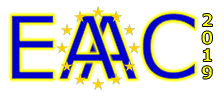Speaker
Description
Laser-driven ion acceleration is an attractive way to realize compact and affordable ion sources for many exciting applications including cancer therapy. Many of these applications require high energy ion beams with narrow
energy spread as well as high flux. When a near critical (or rather overdense) target is irradiated by a laser pulse, ions are compressed to form a density spike, which in turn launches electrostatic shocks in the target. These shocks can reflect upstream ions and yield ion beams with monoenergetic peaks of a few MeV [1]. In this study, we propose to estimate the use of protons to induce reactions in secondary targets to produce radioisotopes of relevance to the nuclear medecine community (b + emitters), like 11C , 13N or 18F via (p,n) or (p,a) reactions. Indeed, these radioisotopes can be produced with lower proton energy, below 35MeV, energy achievable by laser acceleration. Laser ion acceleration is therefore promising to replace cyclotrons by a more flexible devices : laser systems.
In this work, we present the numerical chain formed by PIC [2] and MONTE CARLO [3] codes. First results of radiosiotope production are analysed, as a function of ion acceleration
mechanisms and of targets properties.

